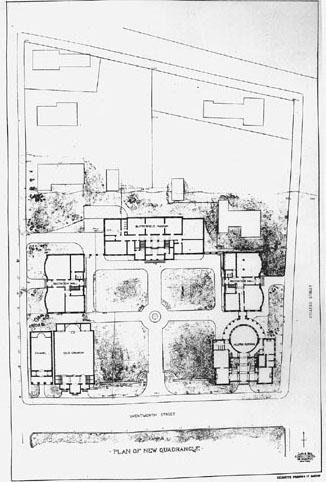

Dartmouth has always been a great steward of its campus. Its long history of campus master planning dates back to the late 1800s and embodies the changing ideals of how a physical campus can support the values of the academic institution.
Charles Rich was the first architect hired from New York in 1895 to establish a new architectural identity for Dartmouth as the College continued to grow its facilities. Under the popular President William Jewett Tucker and his successor President Ernest Fox Nichols, Rich proposed an expansion plan that would have built twelve buildings beyond the Green in several novel form: three-building ensembles imitating Dartmouth Row, three-sided Beaux-Arts quadrangles, residential avenues, and a scenic auto road.
Webster Memorial Hall, now named Rauner Special Collections Library, was added in 1907 as a product of this first effort of master planning. While Rich planned for his subsequent building Hitchcock Hall in 1913, he worked with landscape architect Bremer Whidden Pond to fix the terrain issues on the acquired Hitchcock Estates that extended from West Wheelock Street to the river. As a guide for Hitchcock Hall, Rich laid out an axis that John Russell Pope would improve upon his 1922 master plan for the campus.
 |
| 1895 Charles Rich's quadrangle plan |
The College commissioned a master plan from John Russell Pope in 1922. Pope gives the Green a strong axiality, as he would later do on the Mall in Washington. He formalized the campus by organizing small buildings around the Green and planned a mall off the green where new dormitories would sit. The row was Webster Avenue and soon there after, the Fraternities occupied the row. Facing Charles Rich's Hitchcock Hall, Pope built his first building of his master plan Russell Sage in 1922-23. Larson & Wells which designed the building went on to design Silsby Hall in 1927-28 which was also indicated in Pope's plan.
 |
|
1922-23 John Russell Pope master plan (click to enlarge) |
Jens Frederick Larson of the firm Larson & Wells was one of the school's most prolific designers, with Baker Library and Tuck Mall were the most prominent results. He was the College's architect in residence from 1919 to 1947 and also instructed Modern Art and Architecture in 1926. Larson's work at Dartmouth over the years led to him specializing in Georgian Revival style architecture adopted by college campuses nationally. Baker Library, though iconic, is only a part of an ensemble of buildings by Jens Larson. Larson built Sanborn Hall in 1927-1928, Carpenter Hall (1928-1929) and other residential buildings around town. Both Carpenter and Sanborn face North Main Street on the west side of Baker Library. Sanborn is connected to Baker by a brick arcade, while Carpenter is joined by a two-story wing. In a hallway of that connecting wing is the first fresco of José Orozco.
Jens Frederick Larson's 1928 master plan made the first leap off the Green with a proposal for development on a hilltop clearing that would later become Tuck Business School and Thayer Engineering School.
 |
|
1928 Jens Frederick Larson master plan (click to enlarge) |
With the internationalist president John Sloan Dickey favoring the then not so popular abstract Modernism, the school replaced Larson after WWII with the Boston designer Nelson Wilmarth Aldrich. It was at that time the College ended the one-designer policy as Aldrich helped select outside architects for buildings that he did not design himself. Dartmouth did not welcome Modernism until Campbell & Aldrich designed the Choate Road dormitories of the mid-1950s.
His concepts of the campus were perhaps most controversial when Aldrich and his cousin Nelson Rockefeller, who chaired the building committee, asked Wallace Harrison to design a long awaited art center at the end of the south end of the Green. The Hopkins center opened in 1962 and overtime became the connection and extension of the campus into town.
| C&A master plan (click to enlarge) |
Lo-Yi Chan was hired by the College as a master planning consultant at a time where Classical architecture was back in the mainstream thus was acceptable to the school's administration. Chan's project, the Rockefeller center is Dartmouth's first building to express this post-modern shift, and the transition can be mapped to the building's northeast corner, where the abstract geometries of Rockefeller's long north façade encounter the Georgian formality of its archeological east façade. Chan placed a high Porte Cochere behind the commonly called "Rocky" center to terminate Massachusetts Row. It was also the first time that brick paving was used as a floor for the pedestrian route, a connection that Chan much preferred over vehicular circulation. Lo-Yi Chan's master planning effort follows his predecessors' planning principle by respecting the open spaces and the Green as the core of campus. He pushed for a balance and connective campus making without expanding the campus beyond its walkable boundaries.
| 2002 Lo-yi Chan 5-10 years master plan (click to enlarge) |